GARDENS BY THE BAY

SHADE PERENNIALS & THEIR COMPANIONS - 1
Consider yourself fortunate if you have areas of shade in which to garden. Wonderful choices of shade-tolerant perennials are available today. What to plant with those shade-lovers may be more difficult to determine. Keep in mind there are different types and degrees of shade. Browse through the suggestions below to find companions that will complement perennials already in your gardens.
* Watch for the animated hummingbird and butterfly with the plants that attract them. *
The deer icon indicates plants that deer are not usually attracted to.
   The best time and method to propagate plants can be found on our image-intensive PROPAGATION page.
To help your plants grow their best, check out our FERTILIZATION page.
To create your own plant partnerships based on tried and true color theory, check out our GARDEN COLOR page.
To see if a particular plant is on this page press Ctrl+F, type in the name, then click the Find button. The best time and method to propagate plants can be found on our image-intensive PROPAGATION page.
To help your plants grow their best, check out our FERTILIZATION page.
To create your own plant partnerships based on tried and true color theory, check out our GARDEN COLOR page.
To see if a particular plant is on this page press Ctrl+F, type in the name, then click the Find button.
AEGOPODIUM
Goutweed, Goat's Foot and Snow-On-The-Mountain are all common names for a lovely green and white foliaged perennial. If you don't believe it is invasive, just mention any of these names to gardeners and watch them shiver. We've all tried it and come to regret it. If you absolutely must give it a try, plant it in a pot or somewhere its rapid spread can be controlled.Aegopodium podagraria 'Variegatum': Goutweed, an invasive ground cover, 12-18" tall
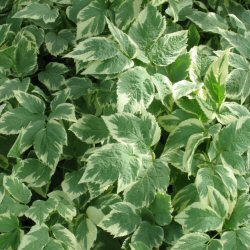
where: under trees, shrubs, in shaded corners
with: Hemerocallis, Ivy, Pachysandra
For more about this lovely but fast-spreading plant, follow the link below.
Aegopodium with variegated foliage
AJUGA
 Bugleweed, which grows in sun or part shade, can be used as a spreading groundcover. Flower spikes are showy in late spring. Select forms with attractive foliage, there are many such, for a prolonged effect.Ajuga reptans: Common Bugleweed, 4-10"x12-18"Ajuga reptans 'Burgundy Glow': bright blue flowers; bronze, green, white and pink variegated foliage
Bugleweed, which grows in sun or part shade, can be used as a spreading groundcover. Flower spikes are showy in late spring. Select forms with attractive foliage, there are many such, for a prolonged effect.Ajuga reptans: Common Bugleweed, 4-10"x12-18"Ajuga reptans 'Burgundy Glow': bright blue flowers; bronze, green, white and pink variegated foliage
with: Crocus goulimyi (lavender-blue) for August bloom
Ajuga 'Silver Beauty'
If blue is your colour, you may wish to check out the forms of this genus at the link below.
blue-flowered Ajuga
Ajuga with silver foliage
Ajuga with variegated foliage
ANEMONE
 The Windflower family has members that bloom in every season. Not all do well in shade, but those below will lighten up your shady corners.
Anemone: spring-blooming types
The Windflower family has members that bloom in every season. Not all do well in shade, but those below will lighten up your shady corners.
Anemone: spring-blooming types
where: shade under shrubs and trees
with: low-growing woodland wildflowers, bulbs & ferns
Anemone blanda: Grecian Windflower, 6-8"x6"
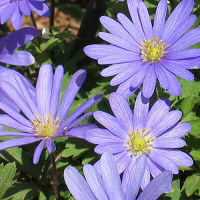
this wonderful plant can be seen in the border around this page and in the photos at the top of the page and just above
under: shade trees; sow sweet alyssum on top to hide dying foliage
among: other colours, i.e. blue, white, pink of other Anemone blanda
with spring bulbs: early Tulipa and miniature Narcissus
with: Tulipa praestans 'Fusilier', Tulipa tarda, Muscari
with: woodland wildflowers, bulbs & ferns
with: smaller Hosta forms
with: Crocus, Scilla
with: Aquilegia, Dicentra eximia, Pulmonaria, Tiarella cordifolia
planted in drifts under: shrubs
to follow: Iris (dwarf beardless types from bulbs)
Anemone blanda 'White Splendor': pure white with yellow centres
where : rock gardens, shady bowers
with : Trillium cuneatum (maroon flowers & mottled foliage)
Anemone nemerosa: Wood Anemone, 4-10"x6"
where: shaded deciduous woodsy areas
with : early Narcissus
with : delicate ferns or Hosta to disguise bare spots left during dormancy
under : Vinca minor
Anemone nemerosa 'Robinsoniana': bright lavender-blue
Anemone sylvestris: Snowdrop Anemone, spring and fall blooms

where: bright woodlands, sunny wild gardens
with: ferns, Phlox, Dicentra spectabilis, Campanula spp.
to co-bloom with: Iris cristata & Mertensia virginica
over: spring bulbs
combined with: Dianthus deltoides (red) & Myosotis alpestris 'Victoria Dark Blue' Many more Anemone choices and their preferred partners can be found below.
blue Anemones
pink Anemones
white Anemones
AQUILEGIA
 No garden is complete without Columbines, in their variety of sizes and colours. If Columbine Leaf Miner spoils the appearance of the foliage, and it will, just cut the plant back and fresh, pest-free growth will appear and persist throughout the remainder of the gardening season.
Aquilegia canadensis: Wild Columbine, Canadian Columbine, 24-30"x12"
Aquilegia flabellata var. nana alba: Fan Columbine, 8-10"x8"
No garden is complete without Columbines, in their variety of sizes and colours. If Columbine Leaf Miner spoils the appearance of the foliage, and it will, just cut the plant back and fresh, pest-free growth will appear and persist throughout the remainder of the gardening season.
Aquilegia canadensis: Wild Columbine, Canadian Columbine, 24-30"x12"
Aquilegia flabellata var. nana alba: Fan Columbine, 8-10"x8"

note: the form in the image above is the lovely blue Aquilegia flabellata 'Blue Angel'
with : Adiantum pedatum
Aquilegia vulgaris
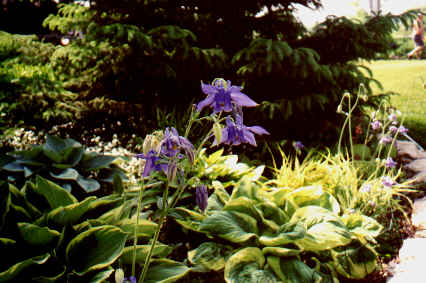
seen in the photo above between Hosta fortunei 'Aureo-marginata' and Hosta 'Carnival'
where: light to moderate shade, against shrubs, perfect in a Hosta garden
note: will attract hummingbirds
Get information on growing and using Columbines to good effect at the pages below.
pink Columbines
red Columbines
white Columbines
Columbines to attract Hummingbirds
ARISAEMA
If your shade is deep, try Jack-In-The-Pulpit, one of our earliest wildflowers. Flowers are followed by bright red berries.
Arisaema triphyllum: Jack-In-The-Pulpit, 12-24"x12-18"

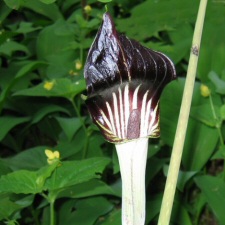
where: among low wildflowers, groundcovers, under shrubs, flowering trees
with: ferns, Dicentra eximia, Sanguinaria canadensis, Hosta
ARUM
Arum, another excellent woodland plant, is a spring bloomer whose white flowers appear in May, followed by orange berries in summer. It is not until fall however that its exotic, arrow-shaped foliage puts in an appearance.Arum italicum 'Pictum': Painted Arum, 12-18"x12"
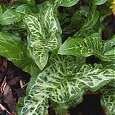
with: a winter-dormant fern to fill the gap during dormancy
Follow the link below for more information about this plant.
Arum with variegated foliage
ARUNCUS
 Goatsbeard, a moisture-loving perennial, has a choice of tall or short forms, all with creamy-white flowers in summer. Foliage is often called "handsome".
Aruncus aethusifolius: Korean Goatsbeard, Dwarf Goatsbeard
Aruncus dioicus: Goatsbeard, 4-6'x3'
Goatsbeard, a moisture-loving perennial, has a choice of tall or short forms, all with creamy-white flowers in summer. Foliage is often called "handsome".
Aruncus aethusifolius: Korean Goatsbeard, Dwarf Goatsbeard
Aruncus dioicus: Goatsbeard, 4-6'x3'
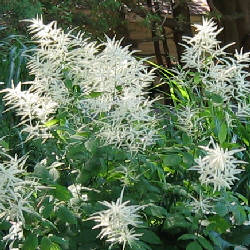
where: lightly shaded woodlands, accent with flowering shrubs, rear of perennial borders
with: groundcovers, wildflowers
behind: Iris sibirica (esp. purple forms), Allium giganteum, ferns
with: Campanula lactiflora (lavender)
behind: Campanula latifolia (deep purple-violet)
Aruncus dioicus 'Kneiffii': 3'
where: smaller gardens, pondside
behind: Geranium x 'Johnson's Blue'
More Goatsbeard information is to be found below.
white Goatsbeard
ASARUM
The Gingers, both native and European, are choice woodland plants, grown for their foliage. I much prefer the European form with its dark green, shiny leaves. The fact that it seeds itself around my dry shady areas is a wonderful bonus.
Asarum canadense: Canada Wild Ginger, 6-12"
where: as a groundcover, along pathways, in shaded rock gardens
with: wildflowers, Hosta, ferns, Trillium, Tiarella
over miniature bulbs: Crocus, Scilla
Asarum europaeum: European Wild Ginger, 6-8"x12"
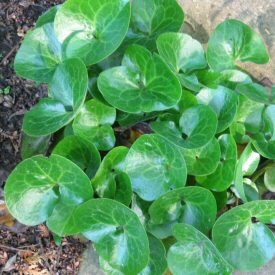
where: alongside a path, groundcover in shade, shaded rock gardens or woodlands
with: ferns (esp. lacy types), wildflowers, Phlox divaricata 'Laphamii', dwarf Narcissus, Aruncus aesthusifolius
with: Polygonatum humile (rare & choice)
ASTER
 Most of the asters we grow prefer full sun, but there are some that put on their best performance when given shady woodland conditions.
Aster: shade-loving types
Most of the asters we grow prefer full sun, but there are some that put on their best performance when given shady woodland conditions.
Aster: shade-loving types
with foliage plants: Hosta, Bergenia, Pulmonaria
Aster dumosus: from 12-24"x12"
with: Molinia caerulea spp. arundinacea
Want to get into the sun with your Asters? Try some of numerous available forms at the links below.
numerous Asters
blue Asters
pink Asters
purple Asters
white Asters
ASTILBE
 The shady conditions these plants prefer can be described as light shade to filtered sun. If you also give them the moisture they crave, they will amaze you with the wonderful show they provide during late spring and summer.Astilbe: Astilbe, False Spirea
The shady conditions these plants prefer can be described as light shade to filtered sun. If you also give them the moisture they crave, they will amaze you with the wonderful show they provide during late spring and summer.Astilbe: Astilbe, False Spireabeside: pond or stream in evenly moist soil
with other moisture-lovers: Hosta, ferns, Alchemilla mollis, Pulmonaria, Dicentra
with: blue, purple or lilac shades, esp. Phlox paniculata
with: Hosta (broad-leaved, untoothed, for foliage combination)
with: fine ferns
offset in front of: Hosta & ferns with Alchemilla mollis in front of all
with: Aquilegia, Bergenia, Cimicifuga, Hemerocallis (esp. yellow), Japanese Iris
with: Lilium, Lythrum, Phlox arendsii (white and pink), Tricyrtis hirta
interplanted with: Tulipa spp. & other hardy spring bulbs (to hide their fading foliage)
combined with: flowers (white and lilac) of Hosta
foliage as foil for: perennials with large, undivided leaves
as contrast, offset in front of: tall, upright-to-arching Ornamental Grasses
to soften: strap-like leaves of Hemerocallis
echo with: red emerging Astilbe foliage to complement the rose or white early flowers of Bergenia
Astilbe: pink
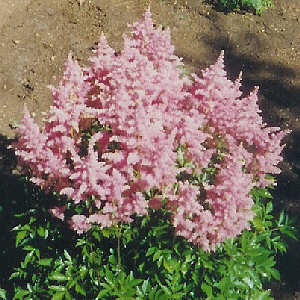
with: same combos as for Astilbe above
Astilbe: red
Astilbe: white
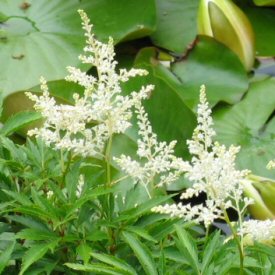
with: Astilbe (other colours), Allium 'Globemaster'
Astilbe x arendsii: Astilbe, 2-4'x24-30"
with: Pulmonaria, Hosta, wildflowers, ferns, Iris, Polygonatum, Alchemilla mollis, Iris sibirica
Astilbe x arendsii 'Bridal Veil': white Mid-season Astilbe, 2' tallwith: early-flowering Oriental Lilies
Astilbe x arendsii 'Fire': coral-red Midseason Astilbe
with: Astilbe (white varieties)
Astilbe chinensis 'Pumila': dwarf pink Astilbe, 10" tall
where: front of border position
combined with: Asarum europaeum, Athyrium goeringianum 'Pictum',
Hosta sieboldiana 'Elegans',
Polygonatum odoratum 'Variegatum' & Convallaris majalis
Astilbe thunbergii 'Ostrich Plume': Thunberg's Astilbe 'Ostrich Plume': coral-pink, 30-36"x24"
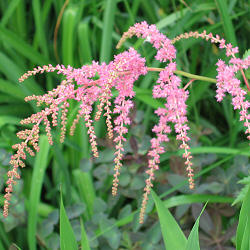
uses: borders, cutting, drying
arching plumes are a wonderful accent in a shady spot
Are your gardens alluring? You might be able to add some dazzle with the use of the complementary partners found at the links below.
Astilbe as edgers
pink Astilbe
white Astilbe
ATHYRIUM
The Lady Ferns are both vigorous and attractive, forming clumps with almost feathery looking fronds. In part shade with evenly moist soil they can quickly provide a ground cover effect.
Athyrium filix-femina: Lady Fern
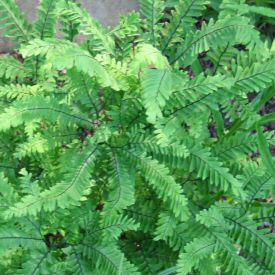
where: full sun or shade with medium moisture
 Athyrium nipponicum 'Pictum': Japanese Painted Fern, 12- 24"x12"
Athyrium nipponicum 'Pictum': Japanese Painted Fern, 12- 24"x12"
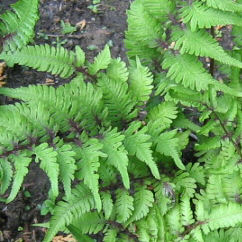
synonym: Athyrium goeringianum 'Pictum'
where : partial shade, moist soil
with : early spring bulbs
combined with : Convallaria majalis, Asarum europeum, Astilbe chinensis 'Pumila', Hosta sieboldiana 'Elegans' & Polygonatum odoratum 'Variegatum'
with : Ajuga 'Catlin's Giant'
There is more information and companionship ideas at the link below.
Athyrium with silver foliage
Athyrium with variegated foliage
BEGONIA
The name Begonia normally calls to mind only annual forms. The Hardy Begonia, however, is hardy to Zone 6 (Zone 5 with protection) and has both lovely foliage and delicate pink flowers.
Begonia grandis: Hardy Begonia, Zone 6, 1-2'x12"
in front of: fine-textured, tall ferns
in front of: dark-leaved plants i.e. Penstemon digitalis 'Husker Red'
Begonia grandis spp. evansiana
where: in rich, moist, well-drained soil in shade
with: Hosta, ferns, woodland plants
Follow the link below for more information on this genus.
pink hardy Begonia
BRUNNERA
Siberian Bugloss will thrive in light to full shade, where it delights with its forget-me-not type flowers and bold foliage, which can sometimes be variegated. Without sufficient moisture, these plants may go dormant so keep well watered in dry periods. Some variegated forms revert to solid green. There are those which do not revert so choose your variegated plants well.
Brunnera macrophylla: Siberian Bugloss, 12-18"x18"
where: groundcover under trees/shrubs
with: bright yellow Narcissus, other spring bulbs
with: Dicentra, Doronicum orientale
with shade-loving foliage plants: Epimedium, Geranium x cantabrigiense 'Biokovo', Pulmonaria, Hosta
with: ferns, wildflowers
Brunnera macrophylla: sky-blue
with: Dicentra eximia
with: Tulipa (pink & white) beside Dicentra spectabilis (pink), all backed by Allium aflatunense 'Purple Sensation',
all behind an edging of Stachys byzantina 'Silver Carpet' & in front of Syringa vulgaris shrubs
Brunnera macrophylla 'Variegata':

this form has gradually produced more solid green leaves although a touch of variegation can still be seen in the lowerand upper left of the image above
the spring-blooming forget-me-not flowers continue to be a delight
many self-sown seedlings have appeared despite the dry shade location and it will be interesting to see whetherthey have any variegation at all in subsequent summers
You will find more information by following the link below.
Brunnera with silvery foliage
Brunnera with variegated foliage
CIMICIFUGA
 Bugbane, also known as Black Cohosh and Snakeroot, is a superb plant for the rear of a shady border. Its tall branching spikes of flowers tower over handsome foliage that will remain effective until the first frosts. Reclassification has changed the name of this genus to Actaea.
Cimicifuga spp.: Bugbane, Black Cohosh, Snakeroot
Bugbane, also known as Black Cohosh and Snakeroot, is a superb plant for the rear of a shady border. Its tall branching spikes of flowers tower over handsome foliage that will remain effective until the first frosts. Reclassification has changed the name of this genus to Actaea.
Cimicifuga spp.: Bugbane, Black Cohosh, Snakerootnow: Actaea
shape contrast behind: fanning Hosta
Cimicifuga racemosa: Black Snakeroot, 3-5'x2'
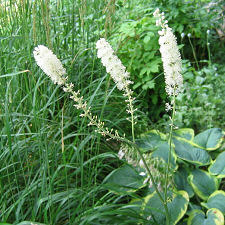
where: rear-border position, in woodland gardens
with rounded plants: Phlox paniculata, Geranium
with: Hemerocallis, Phlox paniculata (esp. pink forms), medium-height ferns, Hemerocallis, Lythrum (rose),
Astilbe (crimson), wildflowers
behind: Lobelia cardinalis, Filipendula rubra 'Venusta'
combined with: hardy Lilium (white) & Phlox paniculata (pink)
behind: Hosta (esp. broad-leaved forms), Hosta (blue-leaved forms)
Cimicifuga simplex ramosa: 3-6', very late-blooming (October in my Zone 5 gardens)
with rounded plants for contrast: Phlox, Geranium
with: pink Phlox, medium height ferns, taller Lilium i.e. Trumpets and Orientals, blue-leaved Hosta, rose Lythrum, Hemerocallis, crimson Astilbe, Filipendula rubra 'Venusta', Iris, Papaver
with: Achillea, Ornamental Grasses, Aster 'Crimson Brocade' (tall, pink)
behind: Lobelia cardinalis
Need more information about growing these perennials? Try the link below.
white Black Snakeroot
CONVALLARIA
Just mention the name Lily-of-the-Valley and you can almost catch the scent of the nodding bell-shaped flowers of this quick-spreading groundcover plant.
Convallaria majalis: Lily-of-the-Valley, 6-8"x12"
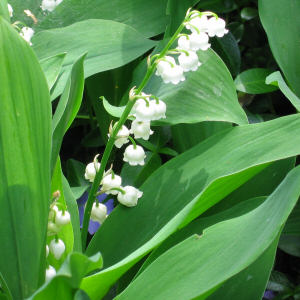
where: edging in shrub border, ground cover under trees & shrubs
with: early bulbs
with: May-blooming blue Phlox i.e. Phlox borealis, Phlox x chatahoochee, Phlox divaricata, Phlox douglasii,
Phlox maculata, Phlox stolonifera, Phlox subulata
If you want to try something different, follow the link below and see what's available.
Lily-of-the-Valley with variegated foliage
CORYDALIS
Corydalis, pronounced koh-RIDD-uh-liss, has tubular flowers that grow in clusters on upright stems over ferny foliage. Not all are yellow as evidenced by the first cultivar mentioned below.
Corydalis flexuosa 'Blue Panda': sky-coloured Blue Corydalis, 8-12"x12"
Corydalis lutea: Golden Corydalis, 8-12"x12"

where: woodland edge, with cool, moisture-retentive, well-drained soil, in a rock wall or on a slope
in front of: Polemonium caeruleum
If you love this genus and want to know more, use the following links for additional information.
yellow Corydalis
DENNSTAEDTIA
 This may be one form that you plant only after careful consideration for it is not intended for small gardens. It has spreading tendencies so would be best limited to use in large areas that need to be filled quickly.
Dennstaedtia punctilobula: Hayscented Fern
This may be one form that you plant only after careful consideration for it is not intended for small gardens. It has spreading tendencies so would be best limited to use in large areas that need to be filled quickly.
Dennstaedtia punctilobula: Hayscented Fern
where: ground cover in sun or shade (may be invasive)
with: naturalized Lilium or Narcissus
DICENTRA
Bleeding Heart is a wonderful plant for somewhat shaded conditions, although it will tolerate full sun with adequate moisture. And surprisingly, it is a good candidate for cutting.
Dicentra: Bleeding Heart
where: shade gardens with ample moisture
with: Tricyrtis hirta, Aquilegia, Epimedium, Phlox divaricata, Tiarella cordifolia
interplanted with spring bulbs: Tulipa spp., dwarf Narcissus forms
massed among: ferns, Hosta, Mertensia virginica, Polygonatum odoratum
 Dicentra eximia: dwarf Fringed Bleeding Heart, 10-18"
Dicentra eximia: dwarf Fringed Bleeding Heart, 10-18"
where: shaded border or woodland garden
in front of: Pulmonaria and Hosta
with: wildflowers, late season Tulipa, Narcissus, ferns
with: Brunnera macrophylla (sometimes called Anchusa myosotidiflora)
over: Endymion hispanicus (Scilla campanulata)
 Dicentra eximia: soft pinks
Dicentra eximia: soft pinks
 Dicentra eximia 'Alba': white Fringed Bleeding Heart, 12"x12"
Dicentra eximia 'Alba': white Fringed Bleeding Heart, 12"x12"
where: woodland gardens in bright shade, moist soil
with: Athyrium niponicum (Japanese Painted Fern), Rhododendron 'Scintillation'
Dicentra x 'Luxuriant': reddish-pink hybrid Fringed Bleeding Heart, 12-16"x12"
where: partly shaded, moist sites, as an edger, in containers
note: blooms best with some direct sun
with: see Dicentra eximia 'Alba'
Dicentra spectabilis: Old-Fashioned Bleeding Heart, 24-30"x24"
where: in woodland setting
with: early dwarf perennials, ferns, wildflowers, groundcovers
with: spring bulbs, late season Tulipa, Primula, Hosta
with: Coreopsis, Iris, Primula, Phlox divaricata, Aquilegia, hardy Geranium spp.
with: Astilbe chinensis 'Pumila' (dwarf), Astilbe chinensis 'Sprite' (dwarf)
with bulbs: Narcissus, Tulipa (esp. pink cultivars 'Esther', 'Rosy Wings' or 'Smiling Queen')
to follow: spring Crocus
above: Polemonium, Brunnera macrophylla
in front of: Gypsophila paniculata (to cover space during mid-summer dormancy)
behind: Veronica 'Crater Lake Blue'
beside: Mertensia virginica, Phlox divaricata 'Alba', Paeonia, Dicentra spectabilis (white-flowered)
Dicentra spectabilis 'Alba': white Old-Fashioned Bleeding Heart
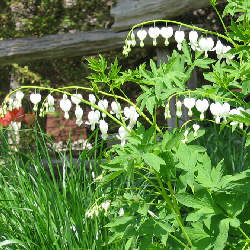
behind: white or other-coloured Tulipa
with: pink-flowered Dicentra spectabilis
There is more information on this genus at the links below.
pink Bleeding Heart
white Bleeding Heart
DISPORUM
Fairy Bells or Mandarin are both common names for this rhizomatous perennial that prefers moist conditions and part to full shade.
Disporum sessile: Japanese Fairy Bells, white, 12-24"
where: partial to full shade
with: Hosta, Astilbe, ferns
with wildflowers: Phlox divaricata, Polemonium reptans, Tiarella cordifolia
DODECATHEON
Left to spread out in either sun or shade, the basal rosettes of attractive foliage of Shooting Star will be topped by flowers with reflexed petals behind front points that look like tiny darts. Try them - you will not be disappointed. They do go dormant after blooming so plant them among other leafy perennials that will spread into the space they vacate.
Dodecatheon meadia: Shooting Star, rose-pink/yellow band, 12-24"x6"
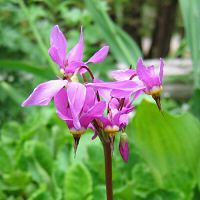
where: woodland gardens
in shade with: dwarf Hosta, woodland Phlox, Primula, Polemonium reptans, Asarum, ferns, Aquilegia spp,
Epimedium spp. (in rock gardens)
generally with: mounding plants i.e. Filipendula rubra, ferns
among: leafy plants to hide bare spots during dormancy
with: roses, Iris, Hemerocallis, Phlox, daisies
with: Monarda, Campanula, Echinacea purpurea, Ornamental Grasses
with: blue Delphinium, Perovskia atriplicifolia, Tanacetum, Valeriana officianalis
combined with: Achillea, Geranium 'Ann Folkard', Ophiopogon planiscapus (black mondo grass),
yellow-flowered Salvia glutinosa, Heuchera americana 'Velvet Knight' & Miscanthus sinensis 'Tiger Cub' (dwarf zebra grass)
You will love this perennial with its cyclamen-like flowers. Follow the link below for more ideas and information.
pink Shooting Star
ENDYMION
Spring would not be complete without the late spring bloom of the Wood Hyacinths. They will bring colour to your shady borders with their nodding bell-shaped flowers, generally in blue, white or pink, growing on graceful stems above the strappy foliage. Also known as Scilla campanulata, formerly called Scilla hispanica, the correct and current name is Hyacinthoides hispanicus. In my garden this is the last of the spring bulbs to bloom.
Endymion hispanicus: Spanish Bluebells, Spanish Squill
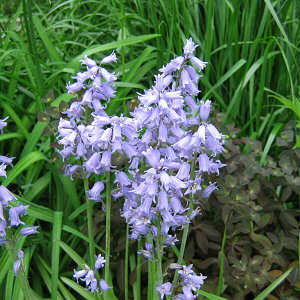
with: ferns, late Narcissus, tall, late Tulipa (any colour), Iris (cream or yellow) intermediate
Endymion hispanicus: a white form
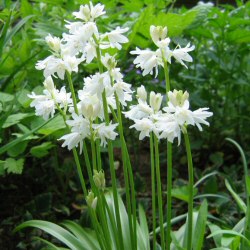
with: ferns, Primula, Trillium
EPIMEDIUMBarrenwort bears starry flowers in spring, but is valued for its semi-evergreen foliage which appears when bloom is finished. The attractive leaves turn bronze in cold weather thus providing a show in more than one season.
Epimedium: Barrenwort - some forms "clump", some "spread"
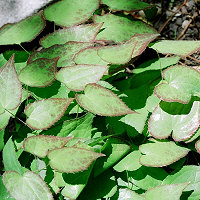
where: groundcover in (dry) shade or woodland gardens
with: Astilbe, Hosta, Primula, Anemone, Helleborus
with: wildflowers, bulbs, ferns
interplanted with spring bulbs: Narcissus, Tulipa, Muscari, Hyacinthoides hispanica
(synonyms - Endymion hispanicus, Scilla campanulata)
Epimedium x versicolor: Persian Epimedium, 10-12"x12"
with: Hosta, wildflowers, ferns, spring bulbs, Helleborus, Primula
ERANTHISThe Aconite bears masses of yellow blooms that can make a woodland area come alive for a brief time in early spring. Don't wait until tulip or daffodil planting time to get these bulbs into the ground however. They need to be planted in late August at the latest to perform their best.
Eranthis hyemalis: Winter Aconite
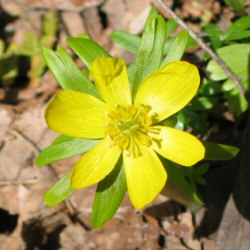
where: shade, woodland banks, as a carpeter in shrub borders
under: Cornus
with: Iris reticulata
combined with: Scilla sibirica, Scilla tubergeniana, Chionodoxa luciliae & Crocus
complementary bloom time: Galanthus nivalis, Scilla bifolia (the earliest-blooming squill) The perfect bulb for shade, Eranthis has wonderful partners that prefer the same conditions. Check them out below.
Eranthis bulbs
ERYTHRONIUMAnother woodlander, the Dogtooth Violet, has nodding blooms in late spring to early summer. Foliage is mottled and provides an element of interest in dappled shade even when the plant is out of bloom.
Erythronium: Trout Lily, Avalanche Lily
where: part shade, in woodsy, constantly moist soil
under shrubs: Philadelphus or Kolkwitzia
with: spring bulbs, wildflowers, early perennials, ferns
among: foliage plants (to hide gaps they leave in mid-summer) i.e. Hosta, Pulmonaria spp., Dicentra eximia,
Erythronium dens-canis: Dogtooth Violet, 4-6"
where: light to moderately-deep shade
with: Anemone blanda 'White Splendor'
among: Hosta, ferns (to cover spaces during dormancy)
Erythronium x 'Pagoda': canary-gold
in front of: Narcissus 'Las Vegas'
For more about this plant, you might want to try the link below.
Trout Lily with variegated foliage
FOR MORE PERENNIALS THAT PREFER SHADY SPOTS IN YOUR GARDEN, FOLLOW THE LINKS BELOW.
All of our own Gardens By The Bay pages can be accessed by clicking on the links below.
HOME
GARDEN POETRY |
GARDEN POETRY MUSE
GEORGIAN BAY VIEW
BOTANICAL LATIN - BASICS
COLOR THEORY
THE GARDENS
CORNER GARDEN CONSTRUCTION |
CORNER GARDEN PLANTING |
LONG GARDEN
EAST GARDEN |
HOSTA GARDEN |
NORTH GARDEN |
WINTER GARDENS
PLANT PARTNERSHIPS
BLUE PERENNIALS Aconitum -
Geranium |
Iris - Vinca
BULBS Allium - Hyacinthus |
Narcissus only |
Tulipa only |
Minor Bulbs
BUTTERFLY MAGNETS Anaphalis - Hemerocallis |
Liatris - Veronicastrum
 DAYLILIES Spider & Unusual Form DAYLILIES Spider & Unusual Form EDGERS Arabis - Iris |
Nepeta - Veronica
FOLIAGE PERENNIALS
Alchemilla - Tanacetum
HOSTA Hosta - all
HUMMINGBIRD-FRIENDLY PERENNIALS Alcea - Salvia
ORANGE PERENNIALS Achillea - Tulipa
ORNAMENTAL GRASSES Acorus - Imperata |
Miscanthus - Spodiopogon
PINK PERENNIALS Achillea - Lilium |
Lychnis - Veronica
PURPLE PERENNIALS Aconitum - Liatris |
Polemonium - Veronica
RED PERENNIALS Achillea - Veronica
SHADE PERENNIALS Aegopodium - Erythronium |
Ferns - Polemonium |
Polygonatum - Vinca
SILVER FOLIAGE PERENNIALS
Achillea - Cerastium
|
Cornus - Limonium
|
Lunaria - Veronica
SIMPLY SPECIAL PERENNIALS Acanthus - Saxifraga
WHITE PERENNIALS Achillea - Iris |
Kalimeris - Yucca
YELLOW PERENNIALS Achillea - Hypericum |
Inula - Verbascum
VARIEGATED-FOLIAGE PERENNIALS Acorus - Erythronium |
Hakonechloa - Lysimachia |
Miscanthus - Yucca
PLANT PROFILES
Dianthus 'Tiny Rubies' |
Geranium |
Geum coccineum |
Kerria japonica |
Knautia macedonica
Paeonia tenuifolia |
Papaver somniferum |
Rudbeckia |
Salvia 'East Friesland'
Trollius |
Veronica 'Sunny Border Blue'
PROPAGATION
DIVISION - SPRING ONLY |
DIVISION - FALL ONLY |
DIVISION - SPRING OR FALL |
DO NOT DIVIDE
FERTILIZATION
EDGERS Arabis - Iris |
Nepeta - Veronica
FOLIAGE PERENNIALS
Alchemilla - Tanacetum
HOSTA Hosta - all
HUMMINGBIRD-FRIENDLY PERENNIALS Alcea - Salvia
ORANGE PERENNIALS Achillea - Tulipa
ORNAMENTAL GRASSES Acorus - Imperata |
Miscanthus - Spodiopogon
PINK PERENNIALS Achillea - Lilium |
Lychnis - Veronica
PURPLE PERENNIALS Aconitum - Liatris |
Polemonium - Veronica
RED PERENNIALS Achillea - Veronica
SHADE PERENNIALS Aegopodium - Erythronium |
Ferns - Polemonium |
Polygonatum - Vinca
SILVER FOLIAGE PERENNIALS
Achillea - Cerastium
|
Cornus - Limonium
|
Lunaria - Veronica
SIMPLY SPECIAL PERENNIALS Acanthus - Saxifraga
WHITE PERENNIALS Achillea - Iris |
Kalimeris - Yucca
YELLOW PERENNIALS Achillea - Hypericum |
Inula - Verbascum
VARIEGATED-FOLIAGE PERENNIALS Acorus - Erythronium |
Hakonechloa - Lysimachia |
Miscanthus - Yucca
PLANT PROFILES
Dianthus 'Tiny Rubies' |
Geranium |
Geum coccineum |
Kerria japonica |
Knautia macedonica
Paeonia tenuifolia |
Papaver somniferum |
Rudbeckia |
Salvia 'East Friesland'
Trollius |
Veronica 'Sunny Border Blue'
PROPAGATION
DIVISION - SPRING ONLY |
DIVISION - FALL ONLY |
DIVISION - SPRING OR FALL |
DO NOT DIVIDE
FERTILIZATION
BULBS |
ORNAMENTAL GRASSES |
PERENNIALS |
SHRUBS |
VINES
LINKS
GARDENS |
LOCAL GARDENS |
BOTANICAL TERMINOLOGY
GARDENING BOOKS |
NON-GARDENING
HOME
|
|
|